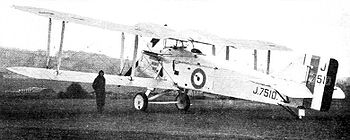Westland Yeovil Video - Picture

|
|
Westland Yeovil
Westland Yeovil

Role: Bomber
National origin: United Kingdom
Manufacturer: Westland Aircraft
First flight: 1925
Status: Retired
Number built: 3
The Westland Yeovil was a biplane bomber launched by Westland Aircraft in 1923. The Yeovil was the first Westland post-war military design to an Air Ministry Specification. The Yeovil competed in the 26/23 Aviation Ministry Britain category. It was specially manufactured to integrate the biggest engine then available, the newly developed 650 hp (480 kW) Rolls Royce Condor, fitted with a Leitner-Watts metal propeller.
Development
The Yeovil was designed for day bombing and therefore it possessed certain characteristics which are not so much needed on machines required for other purposes. In addition, a bomber should have a good degree of positive stability, and should fly very steadily. Otherwise it will be impossible to see the bomb sights effectively. Westland have taken all these point seriously in the designing of the Yeovil. Both the pilot and the observer had a very good view for each of their operations. The pilot was in front and the observer and the trailing edge of the wings.

Picture - The sloping deck provides a good view forward for the pilot, while the rear gunner, being clear of the wings, has a very free field of fire and a good view downwards for bomb sighting.
Only three prototypes were produced, with the following serial numbers: J.7508, J.7509 and J.7510. The first prototype somewhat differed from the other two prototypes. Its undercarriage arrangements and the fairing of the wing tanks were different. The undercarriage had a wide track, and is fitted with oleo shock absorbers. One will notice that the wing section on each side of the centre section is different from the remainder of the wing, it is somewhat thicker. The petrol tanks are housed inside this section, which has high-lift characteristics. The petrol supply is totally powered by gravity, which is a very desirable attribute, especially for a military aeroplane.
This particular prototype made its test flight during the summer of 1925 from RAF Andover, with Captain Frank Courtney as the test pilot. Major L. P. Openshaw was in control of the development testing of this forming prototypes. As the Yeovil was built for the Air Ministry, Westland was not permitted to give any details of its actual performance, but they did say that this is considered highly satisfactory. Several other companies built prototypes to the same specifications, and at the end of the day the Hawker Horsley biplane was the winner of the competition. Hawker also got the production contract. The three Yeovil prototypes that were constructed were used for research work, thereafter their flying careers ended.
Specifications
Data from FLIGHT International
General characteristics
Crew: 2
Length: 11.22 m (36 ft 10 in)
Wingspan: 18.13 m (59 ft 6 in)
Height: 4.34 m (14 ft 3 in)
Wing area: 74.13 m2 (797.93 sq ft)
Empty weight: 2113 kg (4658 lb)
Loaded weight: 3567 kg (7864 lb)
Powerplant: 1x— Rolls-Royce Condor Liquid-cooled, 650 HP (485 kW)
Performance
Maximum speed: 193 km/h (120 mph)
Armament
One gun firing forward and two guns firing backward.
Comparable aircraft
Hawker Horsley
Bristol Berkeley
Handley Page H.P.28 Handcross
Westland Yeovil Pictures and Westland Yeovil for Sale.
Living Warbirds: The best warbirds DVD series.
Source: WikiPedia